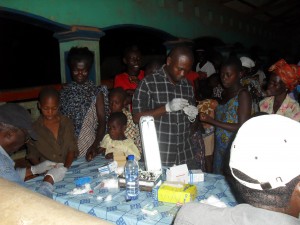Eliminating Trachoma in Ghana: Are We There Yet?
October 27th, 2015
One of the world’s oldest diseases, trachoma still causes more preventable blindness than any other infectious disease today, according to the World Health Organization (WHO). Caused by a bacterial (Chlamydia trachomatis) infection, the painful eye disease is spread by flies or other insects, or through contact with an infected person.
Found across Africa, trachoma affects 37 districts in 2 regions (Northern and Upper West Regions) of the West African country of Ghana. The country started its trachoma elimination program in 2000, following the WHO-recommended strategy for eliminating trachoma, known as the SAFE strategy. The SAFE acronym refers to: S for Surgery to remove in-turned eyelashes, a complication of trachoma known as trachomatous trichiasis (TT); A for treatment with Antibiotics to fight the infection; F for Facial cleanliness, a reference to personal hygiene; and E for Environmental improvements, such as better water and sanitation infrastructure, to reduce disease transmission.
After every community in each affected district had received at least three years of SAFE interventions, studies conducted in 2008 showed that fewer than 5% of children 1-9 years of age tested positive for trachoma (i.e., trachomatous folliculitis, or TF), and around 1% had TT. The WHO determines that trachoma elimination has been achieved in a country if two criteria are met: TF prevalence is < 5% in children 1-9 years of age; and TT prevalence is < 0.1% (or 1 case per 1,000 people). Given the encouraging finding in relation to TF, Ghana was able to stop mass antibiotic treatments in 2009. However, since the TT level still exceeded the WHO-determined maximum, Ghana’s trachoma program continued to conduct TT surgery in the affected districts, with support from NTD partners.
However, since trachoma infections can re-emerge once treatment stops, country Neglected Tropical Disease Programs (NTDP) must regularly monitor districts with previous disease cases to ensure that the disease does not return. Along with other NTD partners, the USAID-funded, FHI360-administered END in Africa project, which has supported Ghana’s integrated NTDP since October 2010, helped Ghana’s NTDP establish a post-treatment trachoma surveillance system for that purpose.
Between 2011 and 2014, the NTDP conducted both active and passive surveillance for TF and TT cases, screening communities and schools in the 37 districts for signs of TF and TT.. During that time, eight communities were found to have TF prevalence > 5% among children 1-9 years. These communities were treated for at least 2 years and then reassessed to ensure that the treatment had been effective, meaning that fewer than 5% of children 1-9 years had the disease. The results of the reassessment indicate that the TT rate has dropped significantly and that it may be < 0.1%, or 1 case per 1,000 people.
In order to verify disease elimination, countries must not only meet the two WHO criteria, but also sustain the criteria for at least three years after treatment has been stopped. As such, Ghana’s NTDP is conducting a district level population based survey in 2015 to verify that the country has sustained both WHO criteria and has thus eliminated blinding trachoma within its borders. The results of this study will be presented to the WHO Regional Peer Review Group for NTDs in Africa, which will decide in 2016-2017 whether Ghana has achieved and sustained the required criteria and verify that it has successfully eliminated trachoma.


